

With Order policies now in hand, I immediately planted my eighth city with a settler that had been waiting on standby. Let's take a look at one of these new cities:
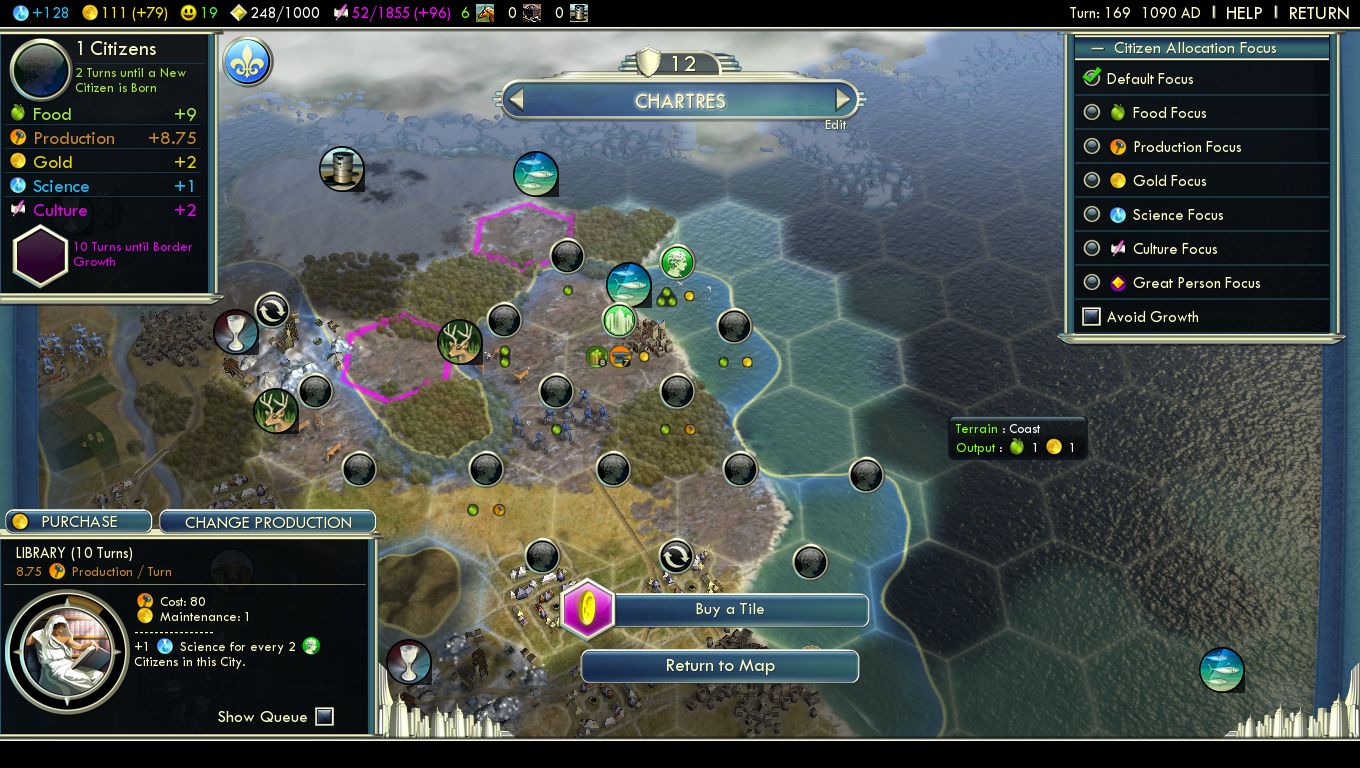
Chartres was a worthless tundra husk of a city. (Not in real life, of course, as I have been there and enjoyed the visit very much!) The fish resource was the only redeeming quality here, because even the deer would only produce 3 food and nothing else when improved. However, I could completely ignore the terrain and get real benefit from Chartres because of the enormous yield from the center tile. Yes, that's 8 food and 7 production there, which every single city received as a result of my Communism policy and magical maritime food. Chartres got a further 25% boost to its building construction from the Order tree itself, which allowed the city to knock out a library in ten turns. Once the library was up, I could run two Scientist specialists for some very nice research out of this marginal location. As for the terrain itself, I don't need to provide food or production thanks to the center tile. The one right choice was to hurl down a trading post on every tile, which transformed even tundra into a half-decent 1/0/2 tile. Very little thought involved, and I would repeat this pattern over and over again with my other filler cities.
By way of keeping track of the mass expansion strategy, I took a lot of Demographics screenshots about 20 turns apart, to demonstrate the explosive growth that was taking place. I'll summarize them for this report in a series of tables. Let's compare before and after grabbing those Order policies:
| Date | Number of Cities | Crop Yield | Manufactured Goods | Beakers per Turn | Gold per Turn | Turn 168 | 7 | 130 | 59 | 127 | 63 | Turn 170 | 8 | 141 | 101 | 134 | 77 |
Obviously the biggest change took place in terms of Manufactured Goods, as the production of all my cities took a major leap upwards. However, I think it's also noteworthy to see how the other numbers also noticeably increased from founding a small filler city. The effects take some time to be felt, but once you get the snowball off and rolling, they add up into a very big total package. You can see from the picture above that I was swimming in happiness, thanks mostly to the State Planning social policy subtracting out an unhappy face from every city. I could easily afford more cities, and that was exactly what I was about to build. Settlers and workers, settlers and workers.

As I continued to fill up my surrounding lands with cities (check out the minimap), Catherine was getting frisky down in the south. She obviously wanted to eliminate Bucharest and expand into that open area to the west. Russia had been at war with the city state for some time, and I guess that wasn't enough because Catherine decided to attack me as well, the ally of Bucharest. This was an invitation for me to drag my old units out of mothballs and send them to assist my little ally. I spent the money to upgrade my archers to crossbows (a paltry 110g each) and my horsemen to knights. The rough terrain made it difficult for the AI to attack effectively, and with my assistance Bucharest managed to fight off the assault, going to super-allied mode in the process. (200 influence!) Of course you don't get anything extra for that, it was just amusing to me to have so much influence with one city state.
In less positive news, Bismarck had the same idea and attacked Venice, the maritime city state next to him who was also my ally. There wasn't much I could do to get my units over there, and unfortunately Venice fell to the enemy. Luckily, I saw this coming a mile away, and was able to save up 1000 gold to instantly ally with another maritime city state, Singapore, which happened to be out on one of the many islands where no AI civs were located. While I did lose out on all the gold I had spent with Venice, and their whales resource, I was able to preserve my economy intact with double maritime food benefit in each city.
Twenty turns after opening up the Order tree, my continent looked very different:

Holy crap, that's a lot of cities!  I'm now up to twelve, and I was forced to pause here briefly for a short span of time while waiting on additional happiness to arrive. I will slip into unhappiness for a little bit here, not that that's much of a problem since it won't affect my research or gold one bit. This was mostly due to the unexpected loss of whales from the fall of Venice; I've got an enormous influx of happiness arriving in 8 turns when those two colosseums complete along with the Forbidden Palace. Then I can go back to expanding again without issue, as I planned to do. Checking the table and comparing against before:
I'm now up to twelve, and I was forced to pause here briefly for a short span of time while waiting on additional happiness to arrive. I will slip into unhappiness for a little bit here, not that that's much of a problem since it won't affect my research or gold one bit. This was mostly due to the unexpected loss of whales from the fall of Venice; I've got an enormous influx of happiness arriving in 8 turns when those two colosseums complete along with the Forbidden Palace. Then I can go back to expanding again without issue, as I planned to do. Checking the table and comparing against before:
| Date | Number of Cities | Crop Yield | Manufactured Goods | Beakers per Turn | Gold per Turn | Turn 168 | 7 | 130 | 59 | 127 | 63 | Turn 170 | 8 | 141 | 101 | 134 | 77 | Turn 189 | 12 | 234 | 156 | 223 | 118 |
The French Empire has put up very sizable increases across the board during the past twenty turns. Crop Yield, Manufacturing, and Beakers per turn are all up by 50% or more. Income has also grown, although not quite as fast as the other metrics. These numbers are slightly misleading, as I was emphasizing Scientist specialists rather heavily on this turn so that I could knock out Physics tech in two turns of research. Check out the picture above to see how I have exactly enough science to do the tech in two turns. Remember, Civ5 currently does not have any research overflow, which means that you must constantly micromanage the discovery of each new technology to avoid massive wastage. (Physics costs 440 beakers to discover. If I were to produce 215 beakers/turn, it would take me three turns to discover the tech, and I would waste 205 beakers.) This is my single biggest irritation with Civ5 at the moment, and bizarrely it is not listed as a fix coming in the first patch. To be honest, I find it embarassing that lack of beaker overflow could even slip into the release version of the game. No one caught this during testing of the game???
Anyway, the next event of note was the completion of the Forbidden Palace in Athens:
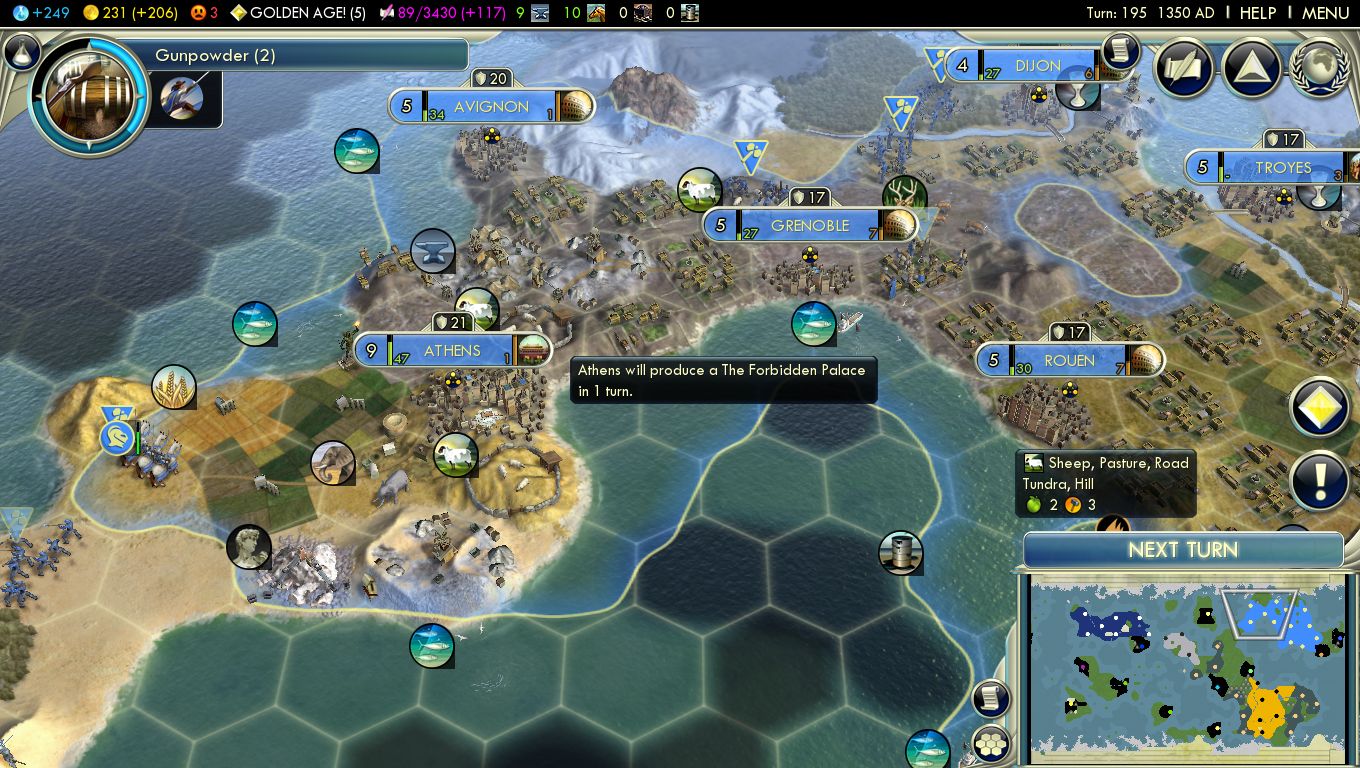
This wonder does exactly the same thing as the Planned Economy policy from the Order tree, reducing "number of cities" unhappiness by 50%. Or, to put it in more sensible terms, it removes one unhappy face from the founding of each new city. Normally, each city produces two unhappy faces + its population in unhappiness. With either one of the Forbidden Palace/Planned Economy, each city will produce one unhappy face + its population. With both, the city simply has unhappiness = population, no penalty for the city at all! Now every city can build a colosseum rather easily, which grants you enough happiness to support four population. If you add Meritocracy's bonus on top of that, now you can support a population of five in every city with zero unhappiness. And that's before counting a single luxury, or natural wonder, or the default happiness you receive on each difficulty level...
Starting to see how easy it can be to expand in this game with the right policies and wonders in place? I consider the Forbidden Palace to be hands-down the best wonder in the game, and it is almost a must-have while playing. The only other really good wonders that I've seen are Chichen Itza (50% longer Golden Ages) and Big Ben (25% cheaper rush buy costs in all cities). The rest of the stuff is either situationally useful, or nice to have but not crucial. I would go on to construct Big Ben in Athens later, and take advantage of the cheaper rush-buy cost to produce lots of colosseums in new cities when happiness was running low. In terms of the larger city spamming tactics, I now believe that you don't have to be quite as stingy in capping growth at size 4. If you can land Meritocracy and one of the State Planning/Forbidden Palace combo, you should be fine to take cities up to size 6-7. Just remember to build circuses wherever possible, and get some theatres in your largest cities, which should be enough to cover it. The ideal number of maritime city states therefore seems to be three; that will get you 11 food/turn in all of your cities after the Renaissance (8 food/turn prior to that) and a disgusting 20 food/turn in your capital. The ideal filler city would be size 6, working one forest or plains trading post (for the 1 food) along with two hill trading posts, and running three specialists (ideally Scientists) with the other three population points. With library and university, that would get you 27 beakers/turn from a city that more than pays for itself in gold and almost breaks even on happiness. Get as many of these cities as you can, and you will annihilate all comers! I'll show some examples of this later on this page, when my initial filler cities reached mature status.
Here's where I stood after another twenty turns:
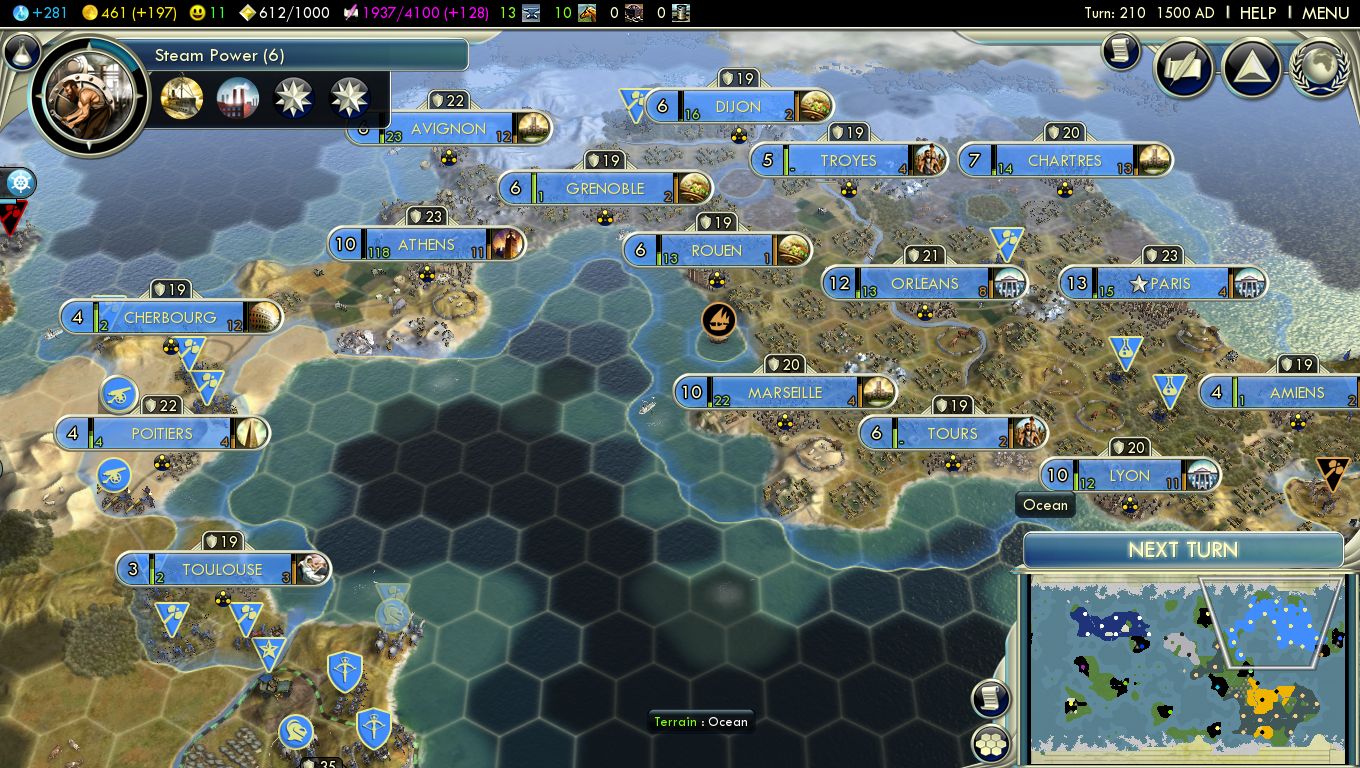
| Date | Number of Cities | Crop Yield | Manufactured Goods | Beakers per Turn | Gold per Turn | Turn 168 | 7 | 130 | 59 | 127 | 63 | Turn 170 | 8 | 141 | 101 | 134 | 77 | Turn 189 | 12 | 234 | 156 | 223 | 118 | Turn 210 | 16 | 310 | 207 | 281 | 197 |
The numbers weren't quite as impressive this time around, as I had stopped building settlers briefly when I ran into that period of unhappiness. More positively, that short period of delay helped me increase me income significantly; the trade routes with all of those little cities poured a lot of additional gold into my coffers. Remember that trades routes are worth 1.25 times the population of the city in income, and thus a whole bunch of size 6-7 cities will produce a considerable amount of wealth. Along with trading posts, you should never lack for money after the early periods of the game. Building up a huge income is very easy to do in Civ5.

Here's a closer look at my original core of cities. Notice that there's a trading post on nearly every single tile; I would build them on the resources too if the game would let me do so! Now you might be asking, why trading posts? What makes them so good? Really, it's not that the trading posts are so good as much that all of the other improvements are so bad. Consider a flatland tile first. There are only two options on grassland or plains tiles: farm or trading post. (I really would like to build something that increases production a lot of the time, however that is not an option in Civ5.) Farms give you food, and they are indeed useful very early in the game. Afterwards, though, there's really no point. Maritime states produce enormously more food, and city growth slows to a pointless crawl beyond size 10. What's the point in building a bunch of farms so that it takes 80 turns to reach size 15 instead of 100 turns? Furthermore, farms don't benefit from Golden Ages at all, which are frequent in this game. Far, far better to build trading posts instead for the extra income, which will indeed get the Golden Age boost. Plains trading posts are actually better than grassland trading posts in most cases, for the same reason.
Then let's consider hills. You have two options with hill tiles, mine or trading post. Mines take the tile from 0/2/0 to 0/3/0, which is useful in a city specifically set up for production but otherwise not really very good. Instead, trading posts will turn hill tiles into 0/2/2 tiles, which the raw numbers rather strongly suggest is superior. And you have the same issue with Golden Ages again: which is better, a 0/4/0 tile or a 0/3/3 tile? Yeah, I know which one I would prefer. Forests are about the only tile where one can make a case for lumbermilling instead of adding trade posts, and in those cases you should probably go with whatever the city needs more, production or gold. Still, in the overwhelming majority of cases, trading posts are the best tile improvement to have. Trading posts are actually BETTER than the bonus resources; I would happily get rid of those stupid sheep on the hill so that I could build a trading post there instead. This is one of the biggest faults of Civ5: the resources have such low yields they become all but irrelevant, and the basic terrain itself is all that matters. It doesn't help either that grassland hill = plains hill = tundra hill = desert hill, and ditto for every forest tile, and grassland = floodplains without distinction between the two. There is a feeling of... sameness about the terrain in Civ5, where everything just sort of runs together. In Civ4, it *MATTERS* where you place your cities, what the terrain looks like, and what resources cities have in their radius. I don't get that same feeling at all with Civ5, which isn't a good thing.
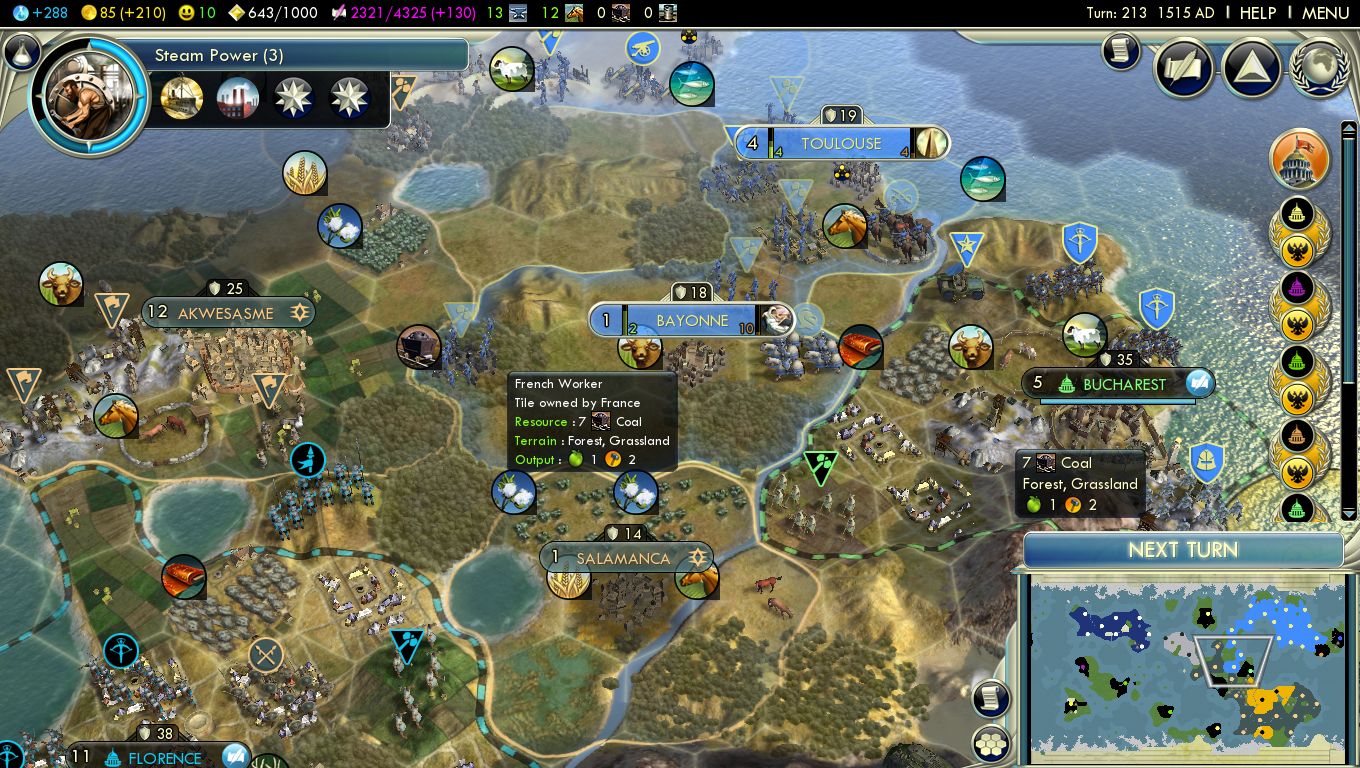
I cash-rushed a settler down here to found Bayonne, as my borders were finally starting to run up against those of the Iroquois. Unfortunately Salamanca grabbed those cotton resources, which were a luxury that I lacked. Fortunately I was able to secure the coal, which was a huge deal because this map had only three sources in the entire world! None anywhere in my half of the continent, despite all that rough terrain. I would end up putting one more settler three tiles west of Toulouse, and then that would be the last place to expand on this continent. You can see from the minimap that Catherine is finally losing her war with Hiawatha, probably because she wasted at least two dozen units trying and failing to capture Bucharest, and thus we are going to end up with a runaway AI empire (in this case the Iroquois) yet again. This seems to happen in literally every single game, because 1) the AIs are all crazy and war incessantly 2) eventually one AI defeats its neighbors and 3) bigger = better in every way for the AIs. While I very much doubt this was the intention of the designers, it's the emergent behavior produced by the AI over and over again. It also does make the game harder, although the formulaity of the whole thing gets pretty tiresome.
I used my large income to continue buying up city state allies (I think I was up to six of them by now, three maritime and three cultured) as well as rushing colosseums in new cities when my happiness approached zero. This sort of thing is very, very easy to do once your income goes up over 200 gold/turn. Here's a look at one or two of my filler cities in more detail:
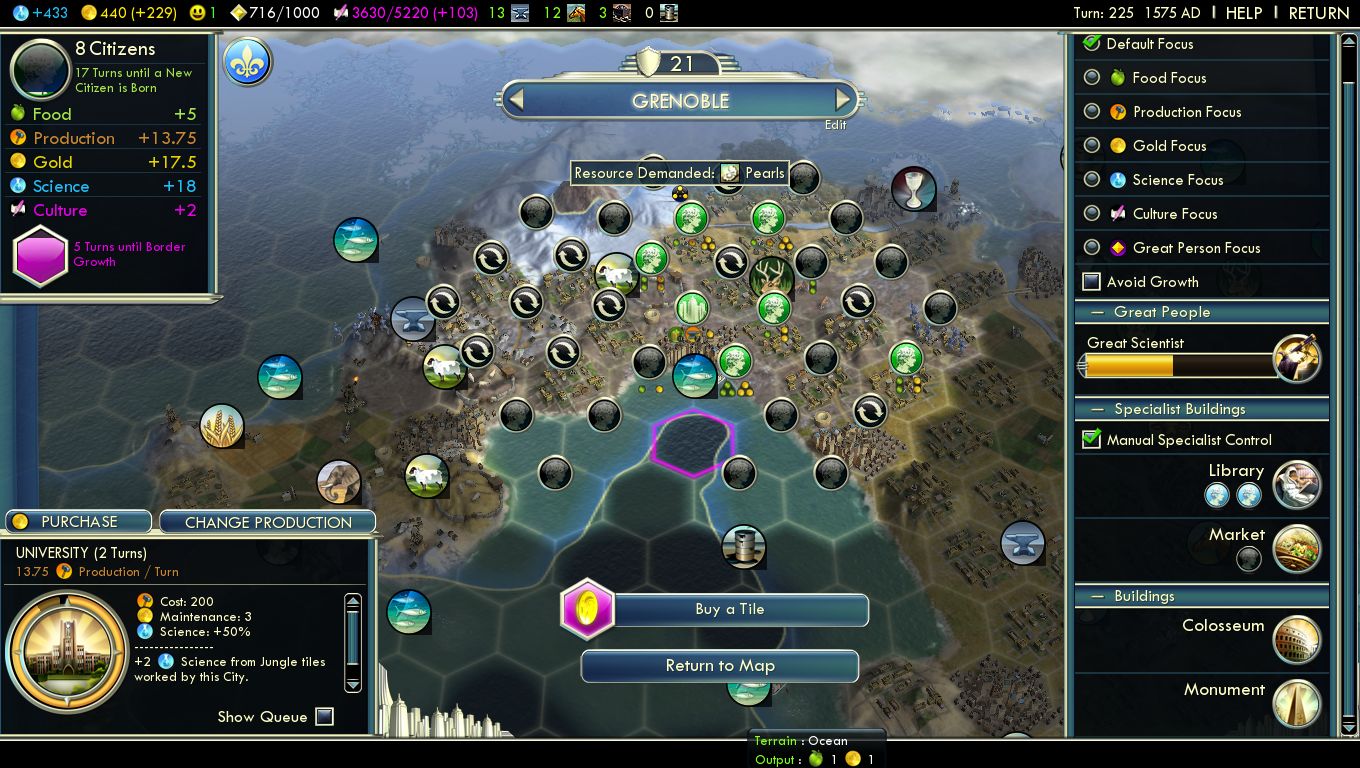
Grenoble lies in the tundra, squeezed in between several other tundra filler cities. Despite that fact, it's working four trading posts and a fish resource, with the remainder of its population running two Scientist specialists. I still have a healthy food surplus of +5, thanks to the incredible power of 11 maritime food on the center tile. This is a very strong gold city, and its science output will increase significantly with that university. I have the basic four buildings that all cities should get (library, monument, colosseum, market) and with all this production from Communism, Grenoble won't have any trouble going on to add a university and then bank. The one thing I don't like about this picture is how difficult it is to see the tiles; I couldn't zoom in closer without obscuring some of them. Here's another city that's easier to see:
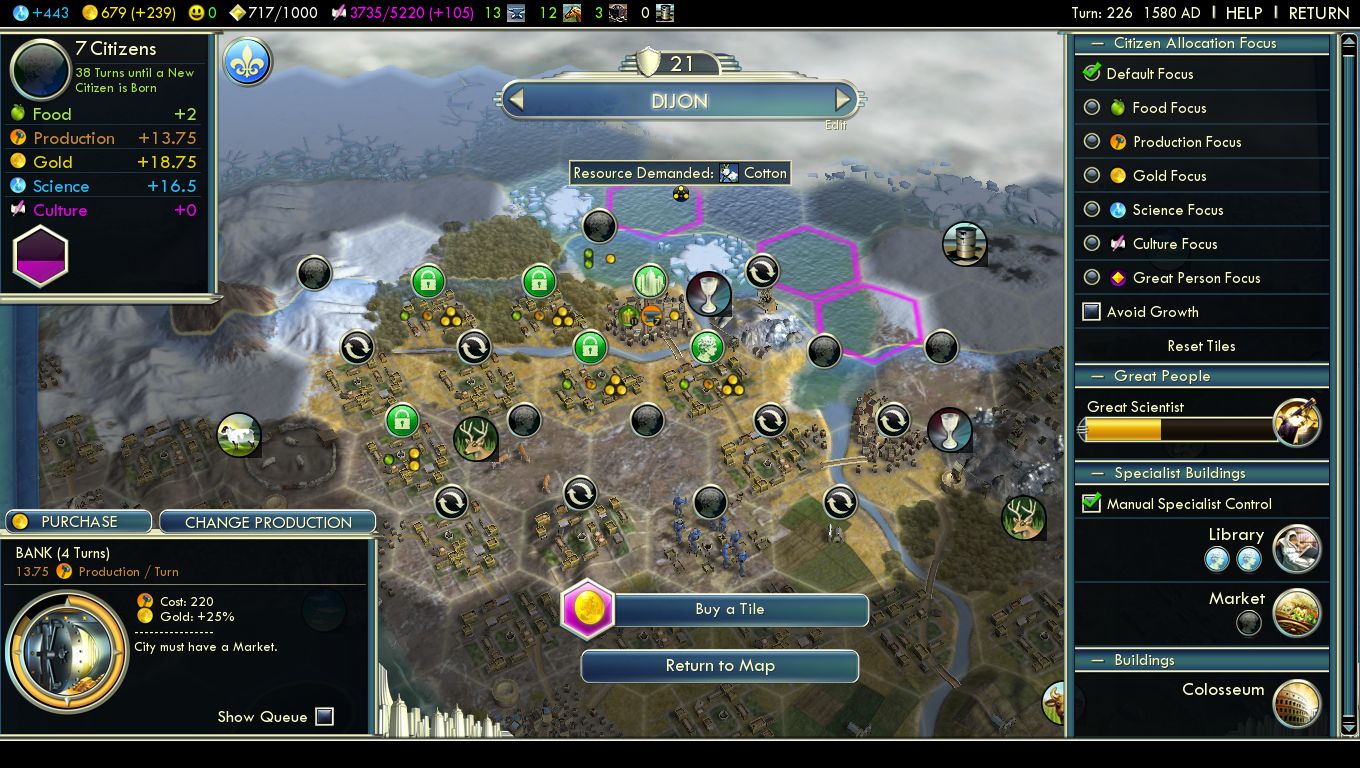
Dijon's land is about as marginal as you can get. However, it has a tiny river flowing next to it, and that makes this a worthwhile location. (Not that you need a river - in Civ5, there is literally no land so bad that you should not found a city there. You can always run specialists and make them worth founding.) Four trading posts on the river bring in very sizable income, and a nice little boost to production as well. In terms of perfect efficiency, I should have chopped those plains forest tiles first, and then built the trading posts, however I was short on worker labor and wanted to save the extra turns. Also note that I accidentally forgot to build a monument here, which I didn't realize until the game was nearly over. Whoops, minor mistake there.
These cities are really great, and make your empire much, much stronger. The problem is their formulaity: there's nothing that distinguishes them or makes them interesting. You're literally building the exact same buildings in every single city, normally in the same order. (My pattern was library, monument, colosseum, market. Library really has to come first for the specialist slots, especially in cruddy land.) Most of these cities didn't have any resources present, and even if they did, I typically ignored the resources in favor of building trading posts on hills or forests/plains. Notice how the deer tile sits unimproved above; it is a 3/0/0 tile even after improvement, worthless. I genuinely prefer the 1/0/2 tundra trading post. Overall, the mass city strategy is overwhelmingly the best choice in terms of how to play Civ5 optimally. However, it's also extremely boring and formulaic. In past Civ games, I loved managing subpar terrain and squeezing out everything possible from the land. I wasn't getting the same pleasure from this game. There's... just nothing to it. Maritime states provide the food, then throw down trading posts. Rinse and repeat everywhere until you win the game. 
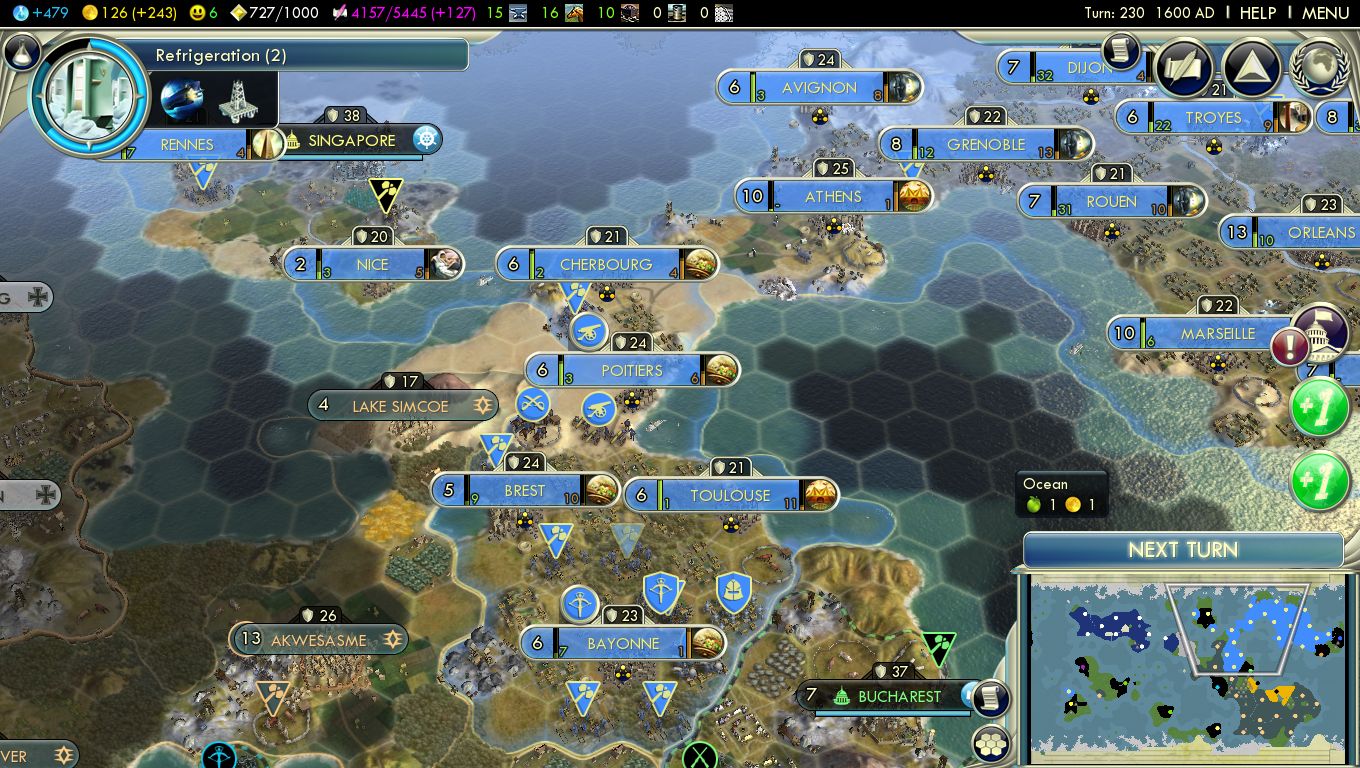
| Date | Number of Cities | Crop Yield | Manufactured Goods | Beakers per Turn | Gold per Turn | Turn 168 | 7 | 130 | 59 | 127 | 63 | Turn 170 | 8 | 141 | 101 | 134 | 77 | Turn 189 | 12 | 234 | 156 | 223 | 118 | Turn 210 | 16 | 310 | 207 | 281 | 197 | Turn 230 | 22 | 421 | 302 | 479 | 243 |
With another twenty turns of reckless expansion, the benefits of the mass city strategy were really starting to make themselves felt. I was #1 in all of these categories by a very sizable margin, and most of the statistical metrics had increased by 30-50% since I last recorded the Demographics. I was literally out of places to go on the main continent, leading me to start throwing down settlers on some of the offshore islands, often in truly hideous iceball locations. They still made me stronger, and were still cities worth founding. If I had had a single large continent to work with, and not had to fool with offshore antics, I would have been even further ahead. The AI has absolutely no answer for this strategy; it can only be effective when it lucks into the same thing by killing other civs and becoming a runaway. Even with all of those cities and the Immortal bonuses, the Iroquois were far, far behind me by now. My explosive growth has raced me past them, and they will never catch up. I could destroy them with ease, if I wasn't intent on playing a peaceful game.
Culturally, I had increased my production to 127 per turn and was still making progress towards new policies at a reasonable rate. However, that number itself was somewhat of a lie, because 80 of the 127 culture was produced by alliances with four cultured city states. Almost 2/3 of my overall total! Imagine what a difference that would make for a smaller empire with fewer cities. We tend to focus on the maritime city states being broken, but really, the cultural ones are almost as bad. They allowed me to continue making progress on the social policy trees with minimal investment in "real" culture on my part.
I had made the decision earlier that I wasn't going to try and conquer the world in this game, even though it would be pretty trivial to do so. (America and Iroquois both had coastal capitals, which basically means game over against any serious attack.) Culture was obviously out, and that meant space or diplo victories. I went for the latter, simply because it would be faster and I had no interest in researching all of the Modern era techs. Using three more Great Scientists, I slingshotted forward to Globalization tech:
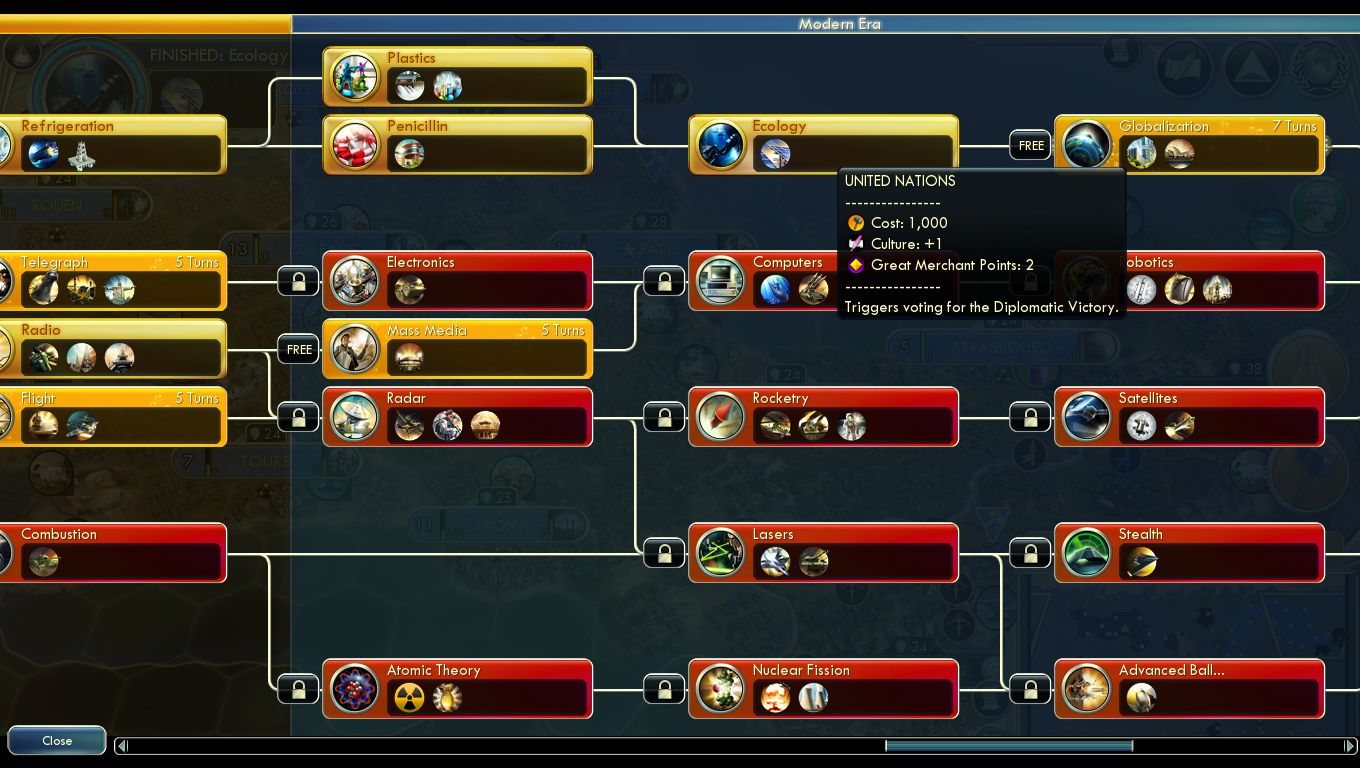
I knocked out Penicillin, Ecology, and Globalization together at one go. (Seriously, those are techs in this game? Really reaching on some of those.) This is how you want to use Great Scientists in this game, by the way. One by itself doesn't do all that much. Save up three or four of them together, however, and you can barrell far down the tech tree into places that you really shouldn't be able to reach yet. Babylon can easily slingshot entire eras with their broken civ abilities. In this game, I probably would have gotten more use by using these Great Scientists for Golden Ages, rather than slightly speeding up the building of the United Nations. I didn't do so because I wanted to do fair comparisons of the numbers every 20 turns, and not figures boosted by Golden Ages. I could have spent the final 30-40 turns of this game in a permanent Golden Age without much trouble, and that would have been a more optimal play.
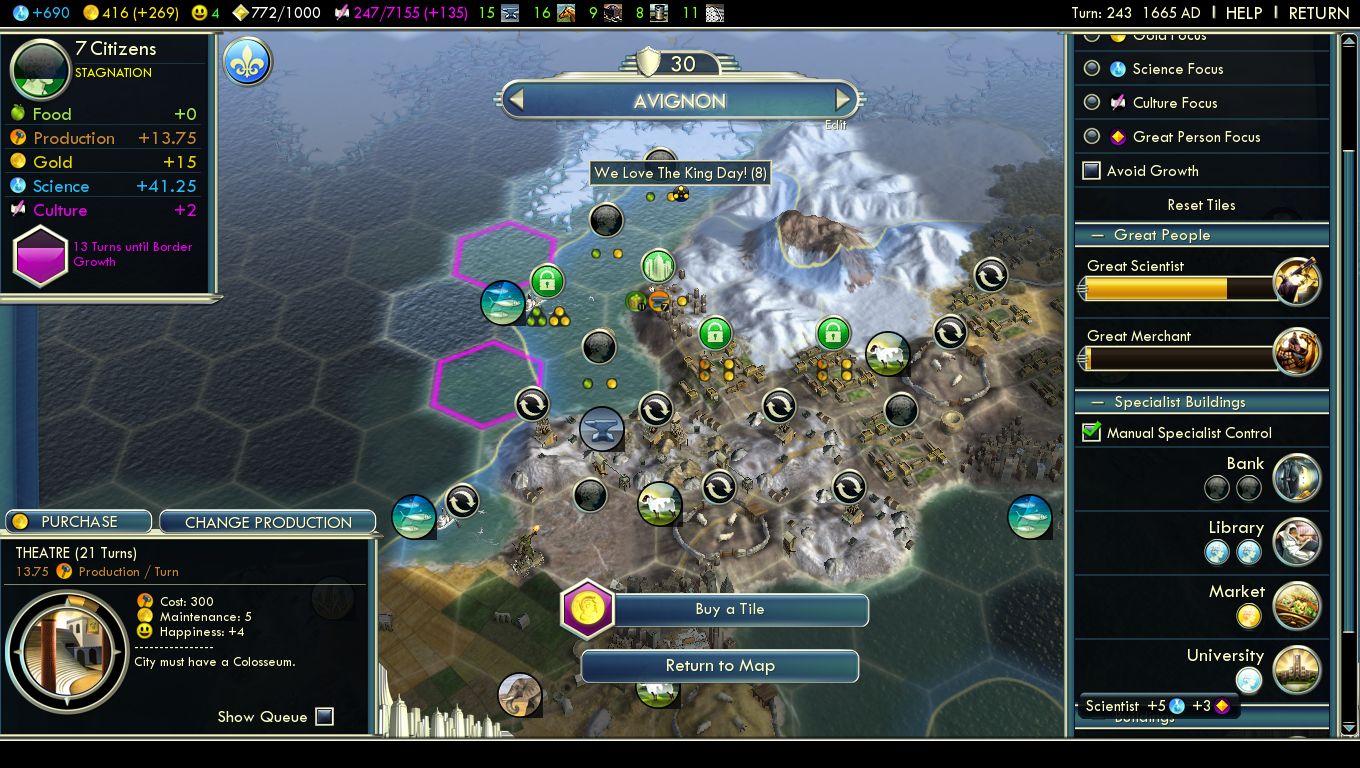
As Athens got to work on the UN, my culture increased to the point where I could take another social policy. I chose to take Rationalism's "Secularism" policy, which adds 2 beakers to every specialist. You can see it at work in the picture above, where the Scientists in Avignon produce 5 beakers each. This was another icy tundra location, capped at size 7 for lack of food and making enough income to pay for its own expenses. Meanwhile, Avignon also produced a very sizable 41 beakers per turn, an extremely good amount given its location. My last two policies after taking the Order tree therefore went into Rationalism, for the default policy and then Secularism. One policy that I did not take was the default Freedom policy, which causes specialists to produce 50% less unhappiness. Basically, every 2 specialists cost 1 unhappiness instead of 2. This was pointed out to me by alpaca in his Infinite Rome game, and indeed Freedom is a really strong policy to take when building a large empire. If I had Freedom, Avignon would be happy neutral (the four specialists producing only two unhappy faces) instead of costing me -2 unhappiness as at present. I didn't use Freedom because I was in pretty good shape for happiness throughout this game, and wanted more science instead to get to the UN faster. Nevertheless, I strongly recommend looking at Freedom as well (just the default policy, not the rest of the tree) for help in managing large empires. It also has the advantage of great flexibility, allowing you to add specialists whenever you need a few more happy faces, which is not something most other policies can do. The ideal policies from a happiness perspective would therefore be Meritocracy, Planned Economy, and Freedom along with the Forbidden Palace. Some combination of them seems really strong to me.
Late in the game, research and production start getting even further out of sync with one another. Check out my tech tree:

This is the entire Modern era tech tree, and I can research everything here in 4-5 turns. It would actually be even faster than that, if there were beaker overflow in this game. Taking into account my own growing population and increasing tech rate, I could probably research every tech in the game in about 45 more turns. Now check out the build times inside one of my best cities:

This is Orleans, my second city and one of the three best cities in my whole empire (Paris, Orleans, and Athens). I've already built a factory and connected it to my capital by railroad; along with the Order tree's 25% building bonus, Orleans is getting a total bonus of 125% towards building construction. This city also gets 18 shields/turn base, which isn't bad at all in this game. (Athens, my city configured for pure production, gets about 30 shields/turn base.) Now look at how long it takes to construct a research lab: 13 more turns, and that's with quite a lot of production already in the thing. A foreign legion similarly took 13 turns to build from scratch, which means that the unit will already be obsoleted by mech infantry before I can even construct the darn thing. Or, instead of building units, I can simply rush-buy them with just over two turns worth of income, anywhere on the map where I happen to have a city. There's no planning involved here, no careful consideration of what I need to be doing a dozen turns down the road. If a situation comes up, I simply throw money at the problem and it solves itself. It's also worth comparing the cost of the research lab to the cost of the United Nations. The reseach lab costs 600 shields, while the UN itself only costs 1000 - huh?!  The wonder isn't even twice as expensive as a normal city improvement. (For comparison, the research lab in Civ3 costs 200 shields against 1000 shields for the United Nations, and in Civ4 the laboratory cost 250 shields against 1000 shields.) That... doesn't feel right.
The wonder isn't even twice as expensive as a normal city improvement. (For comparison, the research lab in Civ3 costs 200 shields against 1000 shields for the United Nations, and in Civ4 the laboratory cost 250 shields against 1000 shields.) That... doesn't feel right.
I simply don't understand why everything is so ungodly expensive to build in this game. There's some genuinely cool stuff to build in the lategame, but I'll never have a chance to see it because the game will be over before that stuff can finish. Similarly, what's the point of having so many modern units (paratroopers, mechs, tanks, helicopters, mobile SAM, a half dozen ships, four types of planes) if it takes 15-20 turns to build a single unit? I'll have five more techs by then! (And of course if you're building units, you can forget about adding any of the lategame buildings.) I'm just baffled by what the design goals behind this setup were supposed to be. Did they think it would be fun to sit around and wait out the egregiously long build times for everything? Are you supposed to delay victory just to play around with this stuff? Whose bright idea was it to make cash-rushing things much, MUCH cheaper than building them normally? (If you pair up Big Ben with Mercantilism from the Commerce tree, it becomes laughable.) The lategame in Civ5 is in very poor shape right now. Techs need to be significantly more expensive, and buildings/units significantly cheaper. And that would only be a start to solving the problem, because we can't even see the real balance issues due to research and production being so very badly out of sync with one another. Oy. This is a real mess.
I completed the United Nations... and then a counter started ticking down ten turns in the top-right corner. Uh, I can see a short delay before voting, but ten turns? What's the point? It's just wasting time in the vast majority of situations, like that whole "wait for the spaceship to arrive" nonsense from Civ4 Beyond the Sword. Anyway, let's take final stock of my empire before the vote:

Check out those enormously long build times across my core cities for modern age buildings, and those are all in cities with factories connected by railroads. Considering that a typical game of Civ5 will be over in 250-300 turns, the very lengthy builds feel far, far out of place. The final Demographics:
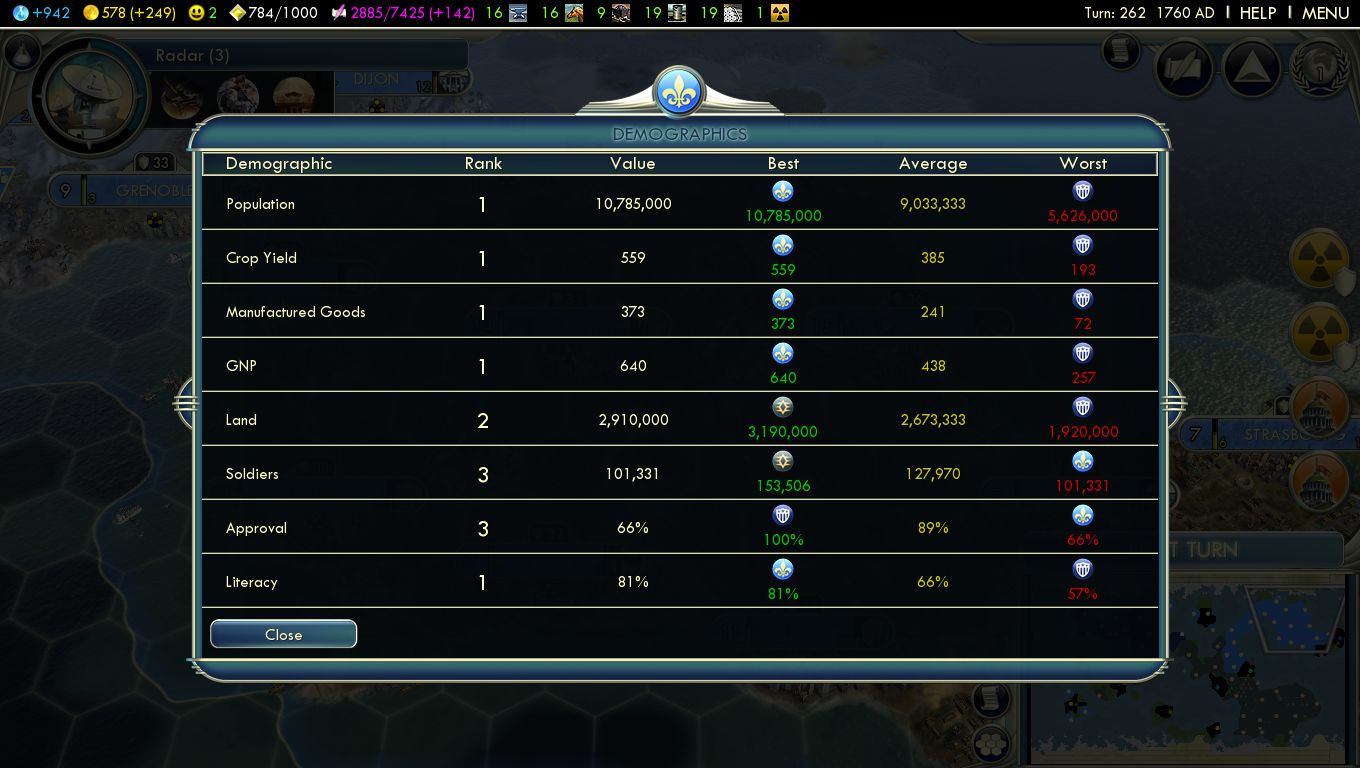
| Date | Number of Cities | Crop Yield | Manufactured Goods | Beakers per Turn | Gold per Turn | Turn 168 | 7 | 130 | 59 | 127 | 63 | Turn 170 | 8 | 141 | 101 | 134 | 77 | Turn 189 | 12 | 234 | 156 | 223 | 118 | Turn 210 | 16 | 310 | 207 | 281 | 197 | Turn 230 | 22 | 421 | 302 | 479 | 243 | Turn 262 | 25 | 559 | 373 | 942 | 249 |
I didn't do much expanding during these last turns, as I was anxious for the game to end. I was also running out of room, and not willing to go to insane lengths just to keep planting more cities. Mostly I threw everything I had into producing more beakers, which resulted in the enormous scientific output of my empire. I was halfway through the Modern era, while Hiawatha was just entering the Industrial age. At least 15 techs ahead, with the gap widening, and that against the game's clear runaway AI. As I said, the AI has absolutely no counter for the mass expansion strategy. If you have land to expand into, you should always win the game playing this way. And I believe that that will hold true on Deity as well.
I was allied with all of the city states, due to easily affordable gold payouts. My influence was over 100 with everyone, well over 100 in many cases. Would things go as expected in the vote?

Yep. The diplomatic victory condition turned out to be just as bad as I feared it out be, where winning the game is simply a matter of tossing money to the city states in return for their votes. With an income of 250 gold/turn, it was trivially easy to ally with anyone and everyone I wanted. I've actually backed off from my earlier favor of the Patronage tree, not because Patronage is weak (it isn't) but simply because it's so unbelievably simple to remain allies with the city states even without Patronage. You might as well spend those policies on something more useful, because it sure doesn't take much skill to befriend all of the city states. The only threat - the ONLY threat - to the player winning by diplomacy is if the AI conquers too many of the city states, which only happens on high difficulty (Emperor or above) and is more a matter of chance than anything else. I've seen plenty of Deity games reported where the AI either can't reach or doesn't bother to attack city states, leading to extremely easy diplo wins. Is this really what we've come to with Civ5? Literally purchasing yourself a victory? 
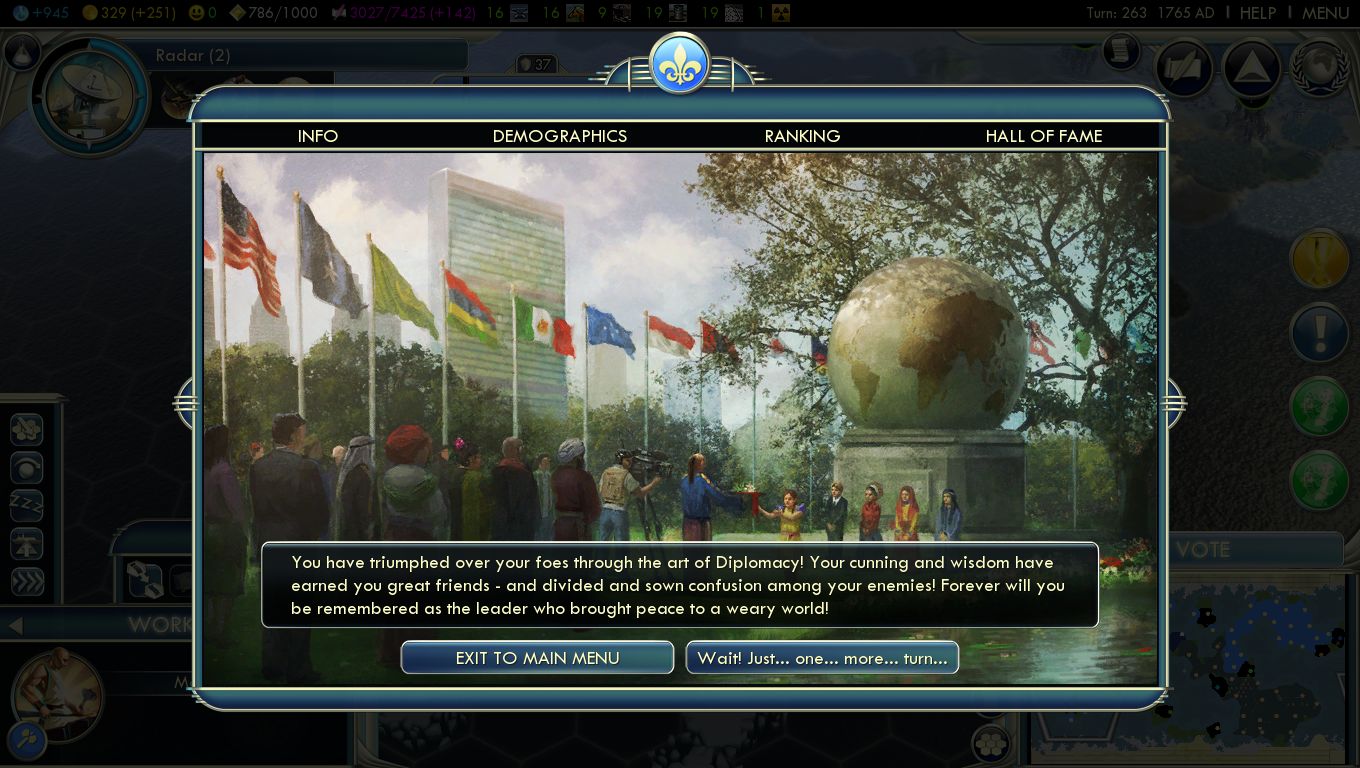
And the incredibly disappointing victory screen. Still no replay or endgame graphs, and still no word about them being restored in a patch. (There actually is code written for Civ5 replays, but naturally the code is disabled and does nothing at present.) All of the cool and interesting extra features of the UN from Civ4, like banning nuclear weapons and forcing global civic changes, are also missing from Civ5. Can't say that I'm surprised.
I had a couple of thoughts I wanted to share at the end of this report. But first, I wanted to include a couple of really insightful posts from our discussion thread at Realms Beyond, which encapsulate a lot of my own feelings about Civ5. For the curious, I did not ask any of the following posters to write these opinions, nor did they read this report before posting to be influenced by my own thoughts:
Zherak Khan: "I'm going to break lurkerdom here for a moment.

Without piling on further, I'll state here that I agreed with all of these opinions, and thought that they were very well written. So... where do we go from here? I feel like I've already figured this game out, and there's not much more to see. I'm going to look to start a succession game with the goal of beating Deity, just for the purposes of accomplishing the feat once (and get some help in playing through long turns of killing the AI's giant swarms of units). Then that's probably it for me and Civ5. I'm not the sort of troll who sticks around a game they don't like just to complain endlessly; I'll move on to other things that provide me with more entertainment.
I've received many messages from different people requesting that the tone of these reports be less negative. Well folks, I'd really like to do that. Truly, I would. But I have to be honest to myself when writing, and I feel that I would be doing a disservice to the reader if I claimed I was having fun when I really wasn't. I don't hold any resentment towards those who are enjoying Civ5; more power to you. I'm obviously not enjoying the game very much though, and I do think that the core design is flawed on some very fundamental levels such as the ones listed above. I'm confident that this game can and will be improved through the patching process; Firaxis will correct the bugs, put in the correct documentation, and fix some of the more glaring imbalances. But will that be enough? There's only so much that they can do through patches, and you'll never see a reworking of the game's core happiness/research mechanics, which are what I view the biggest issues. I'll keep an eye on the community, and hope that things will get better in time. Honestly though, this is probably the final Single Player report I'll be writing on my website for Civ5, and at present there are no plans for a series of competitive Epics games for Civ5 at Realms Beyond.
As always, thanks to all the readers.



